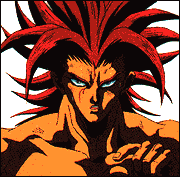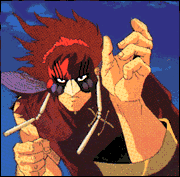 |


Copyright © 1995 Dai Won Animation Company Ltd., Dai Won Publishing
Company Ltd.
Released in America by Manga Entertainment
85 minutes.
English Dubbed
$19.95
UPC: 0-44004-57313-9=20


 |
 |


—by Charles McCarter
"Technically, RED HAWK isn't really anime." Several
people who consider themselves to be authorities on anime told me that. The
reason? Well, it's done in Korea by a Korean staff! (One look at the names
on the box cover and you'll realize that.) But I've got a surprise for
people—anime has been done in Korea for many, many years. I know,
you're probably shocked. Go get yourself a glass of water and some Nuprin
before you read any further.
 What they probably meant to say was that it was done completely
in Korea. Anime has its origins in Japan. The studios reside there, the story,
scripting, character designs and layout are done there, and most often only
the inbetween animation (and more recently now, even key animation) are
outsourced to Korean companies because they can do it cheaper. RED HAWK,
however, is a 100% completely Korean animated product. But let us put its
country of origin aside and get to the important question: is it any good? What they probably meant to say was that it was done completely
in Korea. Anime has its origins in Japan. The studios reside there, the story,
scripting, character designs and layout are done there, and most often only
the inbetween animation (and more recently now, even key animation) are
outsourced to Korean companies because they can do it cheaper. RED HAWK,
however, is a 100% completely Korean animated product. But let us put its
country of origin aside and get to the important question: is it any good?
 Cross Superman with Robin Hood and dump him in YOTODEN and you've got the
basic plot. It almost sounds like a Van Damme or Steven Segal movie. In an
ancient Asian land, an evil syndicate has taken control. The first problem
is with the syndicate's name - the Camelia Blossoms. If I were the head
of a crime syndicate, I'd choose a more awe-inspiring name. The Five Dragons are
the martial-arts enforcers of this syndicate, and are widely feared
throughout the land. (Probably because their name is not
chlorophyll-based). One of these Dragons, a man named Danlyong, escapes with
the aid of his brother, Muklyong. Cross Superman with Robin Hood and dump him in YOTODEN and you've got the
basic plot. It almost sounds like a Van Damme or Steven Segal movie. In an
ancient Asian land, an evil syndicate has taken control. The first problem
is with the syndicate's name - the Camelia Blossoms. If I were the head
of a crime syndicate, I'd choose a more awe-inspiring name. The Five Dragons are
the martial-arts enforcers of this syndicate, and are widely feared
throughout the land. (Probably because their name is not
chlorophyll-based). One of these Dragons, a man named Danlyong, escapes with
the aid of his brother, Muklyong.
 Three years pass, and the Camelia Blossoms have overthrown the
government. The land is in turmoil. Honglyung, a pretty young woman,
is a waitress in a
local restaurant until her father turns up dead. Then she sets out in
search of his killer, with the aid of some of her friends. When she is
attacked, the mysterious Red Hawk turns up to save her. Three years pass, and the Camelia Blossoms have overthrown the
government. The land is in turmoil. Honglyung, a pretty young woman,
is a waitress in a
local restaurant until her father turns up dead. Then she sets out in
search of his killer, with the aid of some of her friends. When she is
attacked, the mysterious Red Hawk turns up to save her.
 Red Hawk is something of a mythic hero and is so named because
"of the red hawk that always accompanies him." Well, thank the gods he wasn't
accompanied by a sloth or a kinkajou or some other more unwieldly-named
animal. Of course, how you can tell Red Hawk the hero from Red Hawk the
Hawk is that the hero is taller. Red Hawk is something of a mythic hero and is so named because
"of the red hawk that always accompanies him." Well, thank the gods he wasn't
accompanied by a sloth or a kinkajou or some other more unwieldly-named
animal. Of course, how you can tell Red Hawk the hero from Red Hawk the
Hawk is that the hero is taller.
 RED HAWK isn't that much different from
most of the fighting anime that is being released by companies in the
United States today. The animation quality is just as high as some of its
more well-known counterparts, and the character designs are familiar yet
distinct enough to set them apart from other shows in this field. The
clothing is different, as well. The characters tend to keep themselves
pretty well covered up, which is unusual in fighting anime. It's a nice
change to see shows where the female characters are not in constant danger
of bouncing out of their clothes. RED HAWK isn't that much different from
most of the fighting anime that is being released by companies in the
United States today. The animation quality is just as high as some of its
more well-known counterparts, and the character designs are familiar yet
distinct enough to set them apart from other shows in this field. The
clothing is different, as well. The characters tend to keep themselves
pretty well covered up, which is unusual in fighting anime. It's a nice
change to see shows where the female characters are not in constant danger
of bouncing out of their clothes.
 In fact, if there is one place where RED
HAWK really falls down it is the music. The score sounds like it
was done by two guys in a studio apartment with a Casio keyboard—you
know, the portable kind you hauled to a music theory class in college so
you can practice hearing tones and chords. In fact, if there is one place where RED
HAWK really falls down it is the music. The score sounds like it
was done by two guys in a studio apartment with a Casio keyboard—you
know, the portable kind you hauled to a music theory class in college so
you can practice hearing tones and chords.
 All in all, RED HAWK is an admirable
effort. And while the story is somewhat predictable, the animation and
production values are all good. Are they as good as Japan's? It depends.
Yes, the production values in RED HAWK are comparable
to many other OVAs that I have seen of late. But,
like everything else, it is not fair to judge the entire Korean animation
industry. All in all, RED HAWK is an admirable
effort. And while the story is somewhat predictable, the animation and
production values are all good. Are they as good as Japan's? It depends.
Yes, the production values in RED HAWK are comparable
to many other OVAs that I have seen of late. But,
like everything else, it is not fair to judge the entire Korean animation
industry.
 |
 |


